2015 TOYOTA AVENSIS weight
[x] Cancel search: weightPage 56 of 648
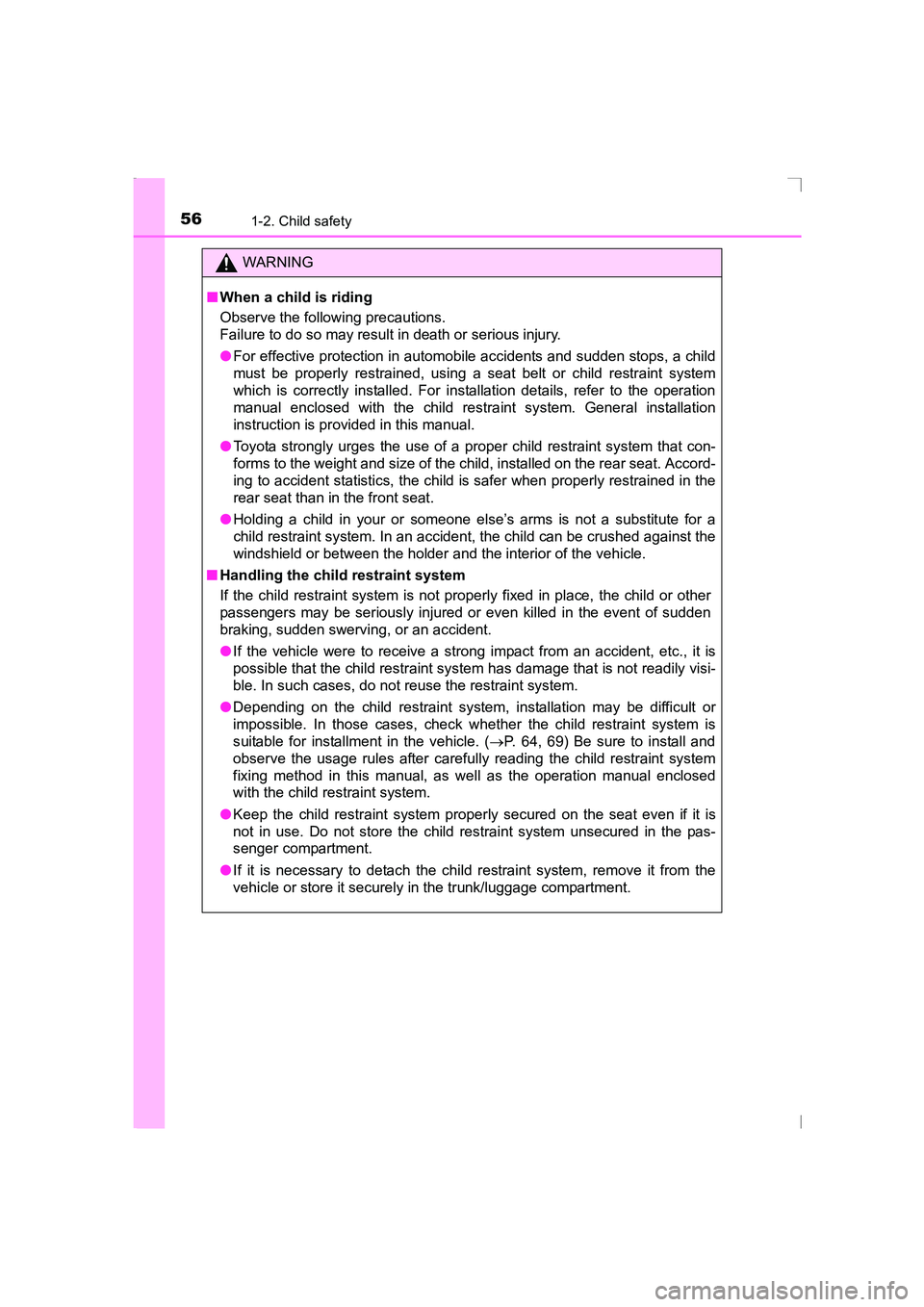
561-2. Child safety
AVENSIS_OM_OM20C20E_(EE)
WARNING
■ When a child is riding
Observe the following precautions.
Failure to do so may result in death or serious injury.
●For effective protection in automobile accidents and sudden stops, a child
must be properly restrained, using a seat belt or child restraint system
which is correctly installed. For installation details, refer to the operation
manual enclosed with the child restraint system. General installation
instruction is provided in this manual.
● Toyota strongly urges the use of a proper child restraint system that con-
forms to the weight and size of the child, installed on the rear seat. Accord-
ing to accident statistics, the child is safer when properly restrained in the
rear seat than in the front seat.
● Holding a child in your or someone else’s arms is not a substitute for a
child restraint system. In an accident, the child can be crushed against the
windshield or between the holder and the interior of the vehicle.
■ Handling the child restraint system
If the child restraint system is not properly fixed in place, the child or other
passengers may be seriously injured or even killed in the event of sudden
braking, sudden swerving, or an accident.
●If the vehicle were to receive a strong impact from an accident, etc., it is
possible that the child restraint system has damage that is not readily visi-
ble. In such cases, do not reuse the restraint system.
● Depending on the child restraint system, installation may be difficult or
impossible. In those cases, check whether the child restraint system is
suitable for installment in the vehicle. ( →P. 64, 69) Be sure to install and
observe the usage rules after carefully reading the child restraint system
fixing method in this manual, as well as the operation manual enclosed
with the child restraint system.
● Keep the child restraint system properly secured on the seat even if it is
not in use. Do not store the child restraint system unsecured in the pas-
senger compartment.
● If it is necessary to detach the child restraint system, remove it from the
vehicle or store it securely in the trunk/luggage compartment.
AVENSIS_OM_OM20C20E_(EE).book Page 56 Thursday, January 29, 2 015 1:47 PM
Page 57 of 648
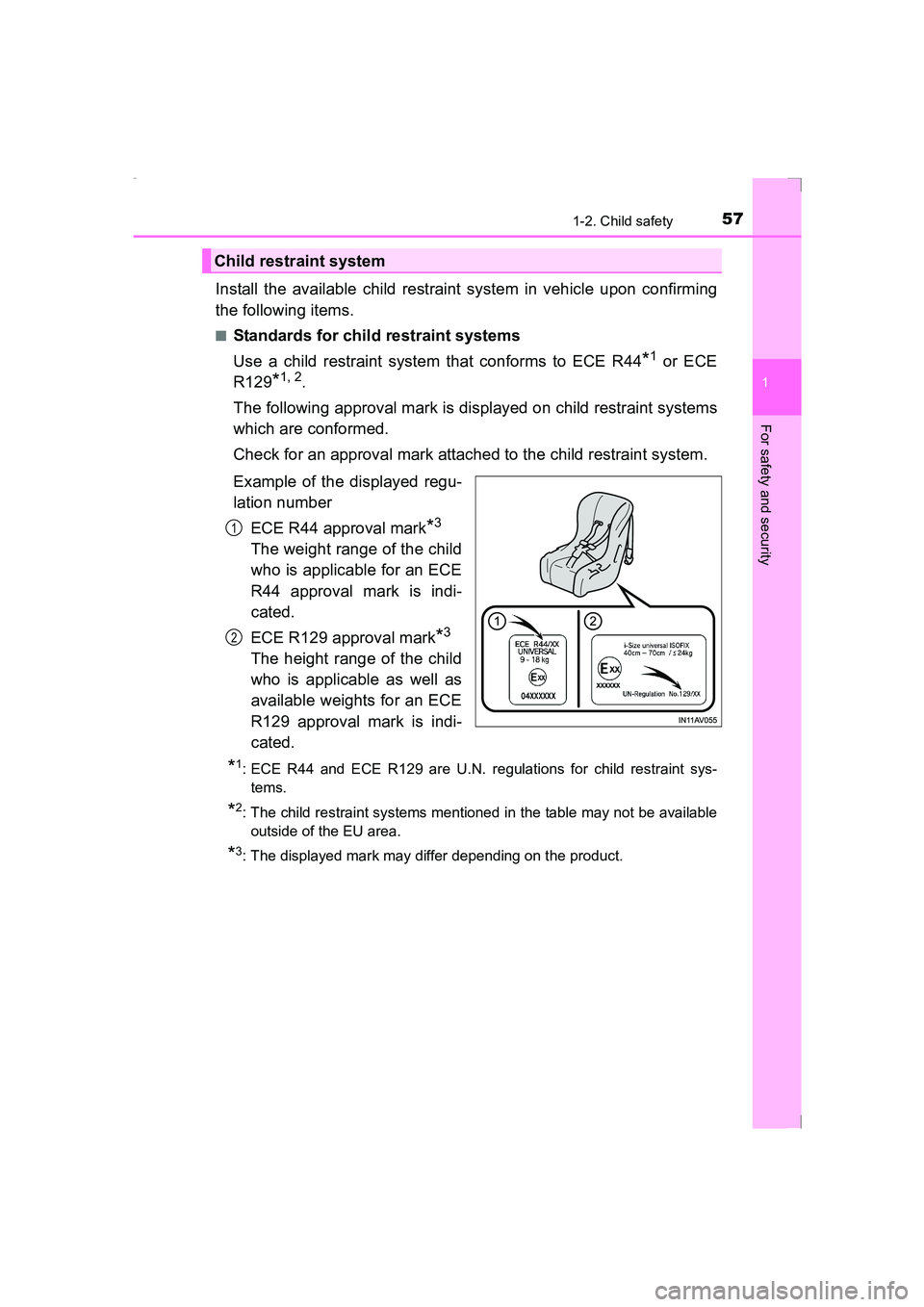
571-2. Child safety
1
AVENSIS_OM_OM20C20E_(EE)
For safety and security
Install the available child restraint system in vehicle upon confirming
the following items.
■Standards for child restraint systems
Use a child restraint system that conforms to ECE R44
*1 or ECE
R129
*1, 2.
The following approval mark is displayed on child restraint systems
which are conformed.
Check for an approval mark attached to the child restraint system.
Example of the displayed regu-
lation number ECE R44 approval mark
*3
The weight range of the child
who is applicable for an ECE
R44 approval mark is indi-
cated.
ECE R129 approval mark
*3
The height range of the child
who is applicable as well as
available weights for an ECE
R129 approval mark is indi-
cated.
*1: ECE R44 and ECE R129 are U.N. regulations for child restraint sys-tems.
*2: The child restraint systems mentioned in the table may not be availableoutside of the EU area.
*3: The displayed mark may differ depending on the product.
Child restraint system
1
2
AVENSIS_OM_OM20C20E_(EE).book Page 57 Thursday, January 29, 2 015 1:47 PM
Page 58 of 648
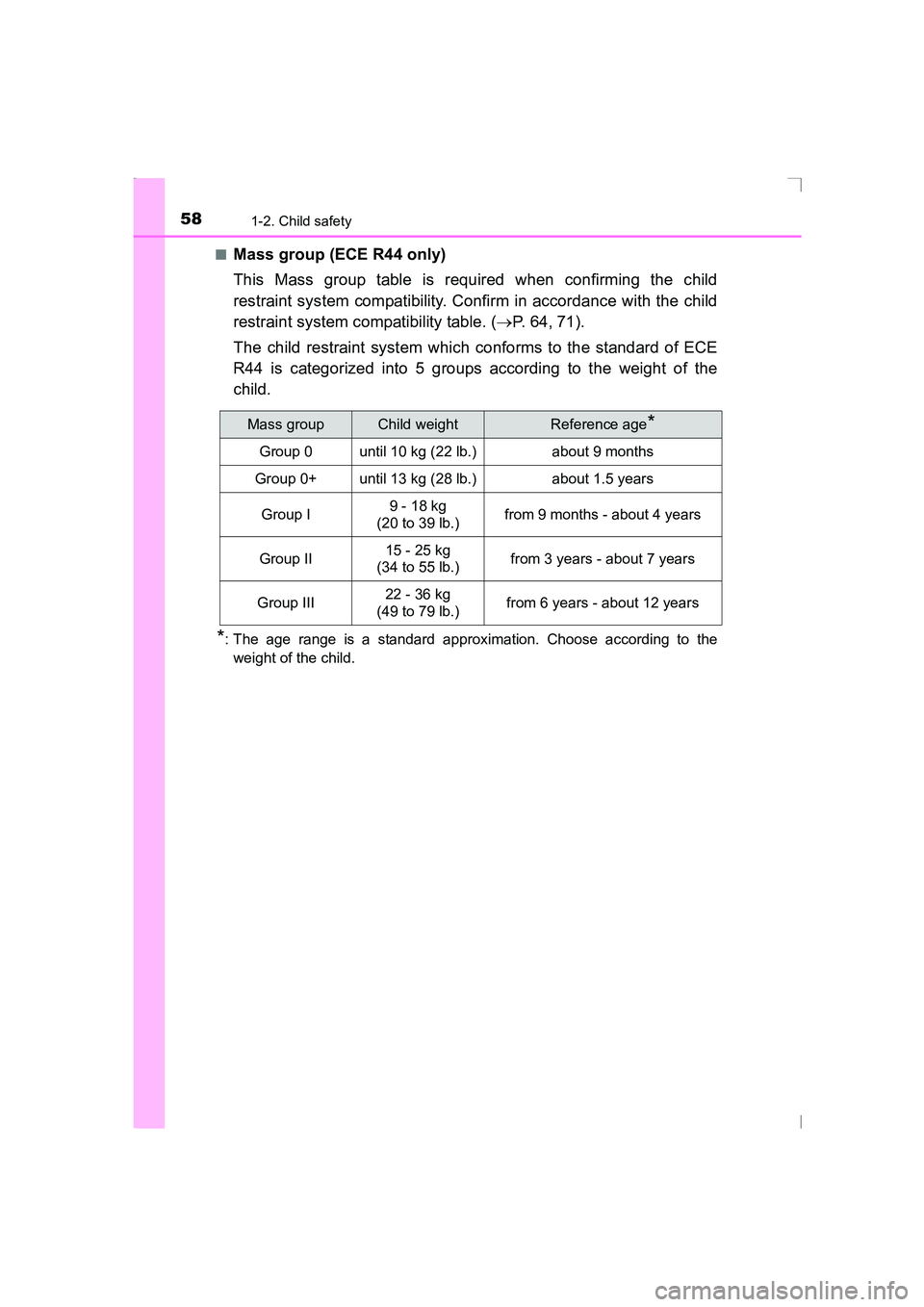
581-2. Child safety
AVENSIS_OM_OM20C20E_(EE)■
Mass group (ECE R44 only)
This Mass group table is required when confirming the child
restraint system compatibility. Confirm in accordance with the child
restraint system compatibility table. (
→P. 6 4 , 71).
The child restraint system which conforms to the standard of ECE
R44 is categorized into 5 groups according to the weight of the
child.
*: The age range is a standard approximation. Choose according to the weight of the child.
Mass groupChild weightReference age*
Group 0until 10 kg (22 lb.)about 9 months
Group 0+until 13 kg (28 lb.)about 1.5 years
Group I9 - 18 kg
(20 to 39 lb.)from 9 months - about 4 years
Group II15 - 25 kg
(34 to 55 lb.)from 3 years - about 7 years
Group III22 - 36 kg
(49 to 79 lb.)from 6 years - about 12 years
AVENSIS_OM_OM20C20E_(EE).book Page 58 Thursday, January 29, 2 015 1:47 PM
Page 64 of 648
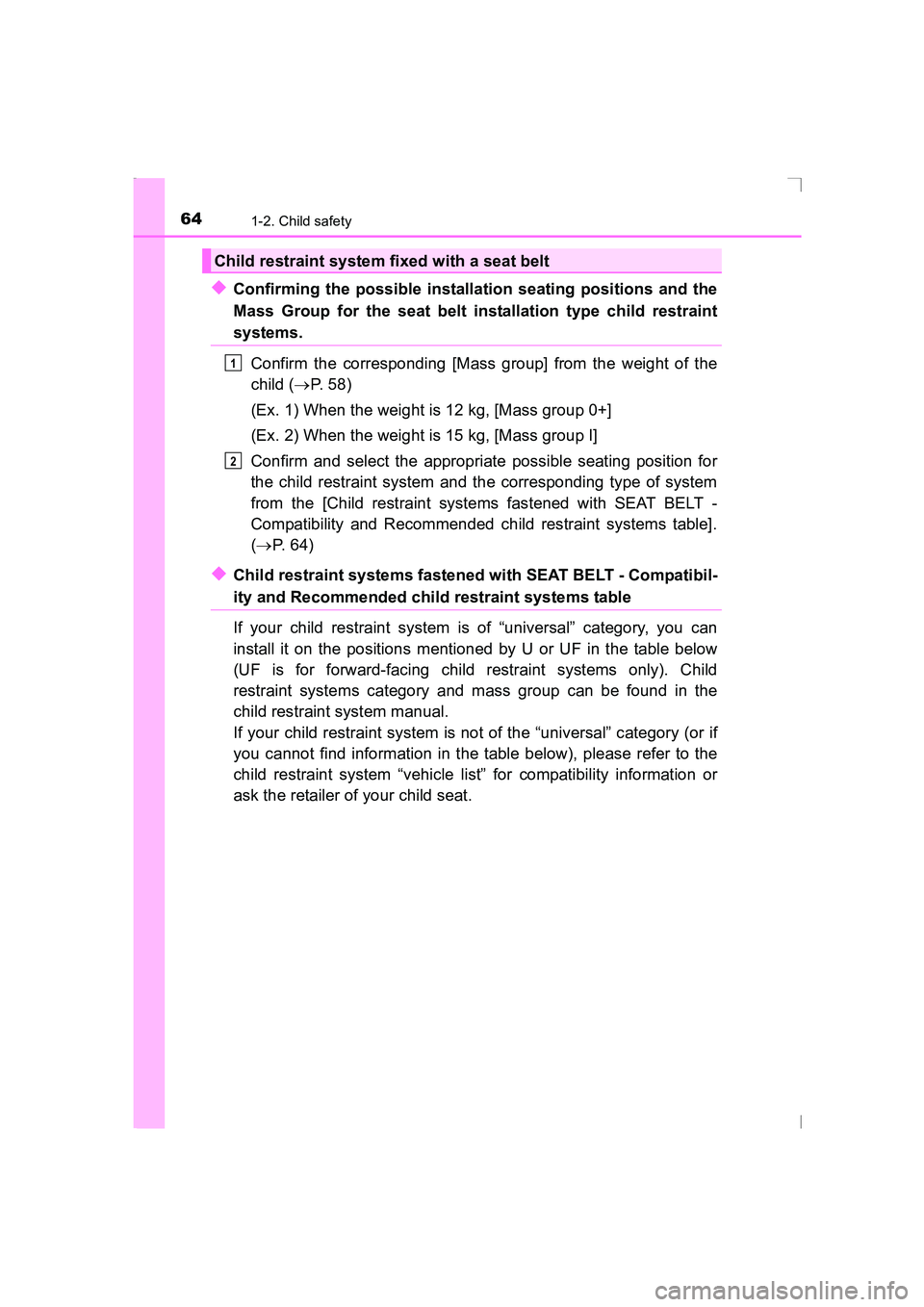
641-2. Child safety
AVENSIS_OM_OM20C20E_(EE)
◆Confirming the possible installation seating positions and the
Mass Group for the seat belt installation type child restraint
systems.Confirm the corresponding [Mass group] from the weight of the
child ( →P. 58)
(Ex. 1) When the weight is 12 kg, [Mass group 0+]
(Ex. 2) When the weight is 15 kg, [Mass group I]
Confirm and select the appropriate possible seating position for
the child restraint system and the corresponding type of system
from the [Child restraint systems fastened with SEAT BELT -
Compatibility and Recommended child restraint systems table].
( → P. 6 4 )
◆Child restraint systems fastened with SEAT BELT - Compatibil-
ity and Recommended child restraint systems table
If your child restraint system is of “universal” category, you can
install it on the positions mentioned by U or UF in the table below
(UF is for forward-facing child restraint systems only). Child
restraint systems category and mass group can be found in the
child restraint system manual.
If your child restraint system is not of the “universal” category (or if
you cannot find information in the table below), please refer to the
child restraint system “vehicle list” for compatibility information or
ask the retailer of your child seat.
Child restraint system fixed with a seat belt
1
2
AVENSIS_OM_OM20C20E_(EE).book Page 64 Thursday, January 29, 2 015 1:47 PM
Page 70 of 648
![TOYOTA AVENSIS 2015 Owners Manual 701-2. Child safety
AVENSIS_OM_OM20C20E_(EE)■
Confirming the Mass group and Size class for ECE R44 ISOFIX
corresponding child restraint systems
Confirm the corresponding [Mass group] from the weight TOYOTA AVENSIS 2015 Owners Manual 701-2. Child safety
AVENSIS_OM_OM20C20E_(EE)■
Confirming the Mass group and Size class for ECE R44 ISOFIX
corresponding child restraint systems
Confirm the corresponding [Mass group] from the weight](/manual-img/14/59657/w960_59657-69.png)
701-2. Child safety
AVENSIS_OM_OM20C20E_(EE)■
Confirming the Mass group and Size class for ECE R44 ISOFIX
corresponding child restraint systems
Confirm the corresponding [Mass group] from the weight of the
child ( →P. 58)
(Ex. 1) When the weight is 12 kg, [Mass group 0+]
(Ex. 2) When the weight is 15 kg, [Mass group I]
Confirming Size class
Select the Size class corresponding to [Mass group] confirmed in
step from the [Child restraint systems fastened with ISOFIX
(ECE R44) - Compatibility and Recommended child restraint sys-
tems table] ( →P. 7 1 )
*.
(Ex. 1) When [Mass group 0+], the corresponding size class is [C], [D], [E].
(Ex. 2) When [Mass group I], the corresponding size class is [A], [B], [B1], [C], [D].
*: However, listings that are marked with [X] can not be selected, despitehaving the corresponding size class in the suitability table of the [Seat-
ing position]. Also, select the product designated by [Recommended
Child Restraint Systems] ( →P. 72), if the listing is marked with [IL].
1
2
1
AVENSIS_OM_OM20C20E_(EE).book Page 70 Thursday, January 29, 2 015 1:47 PM
Page 142 of 648
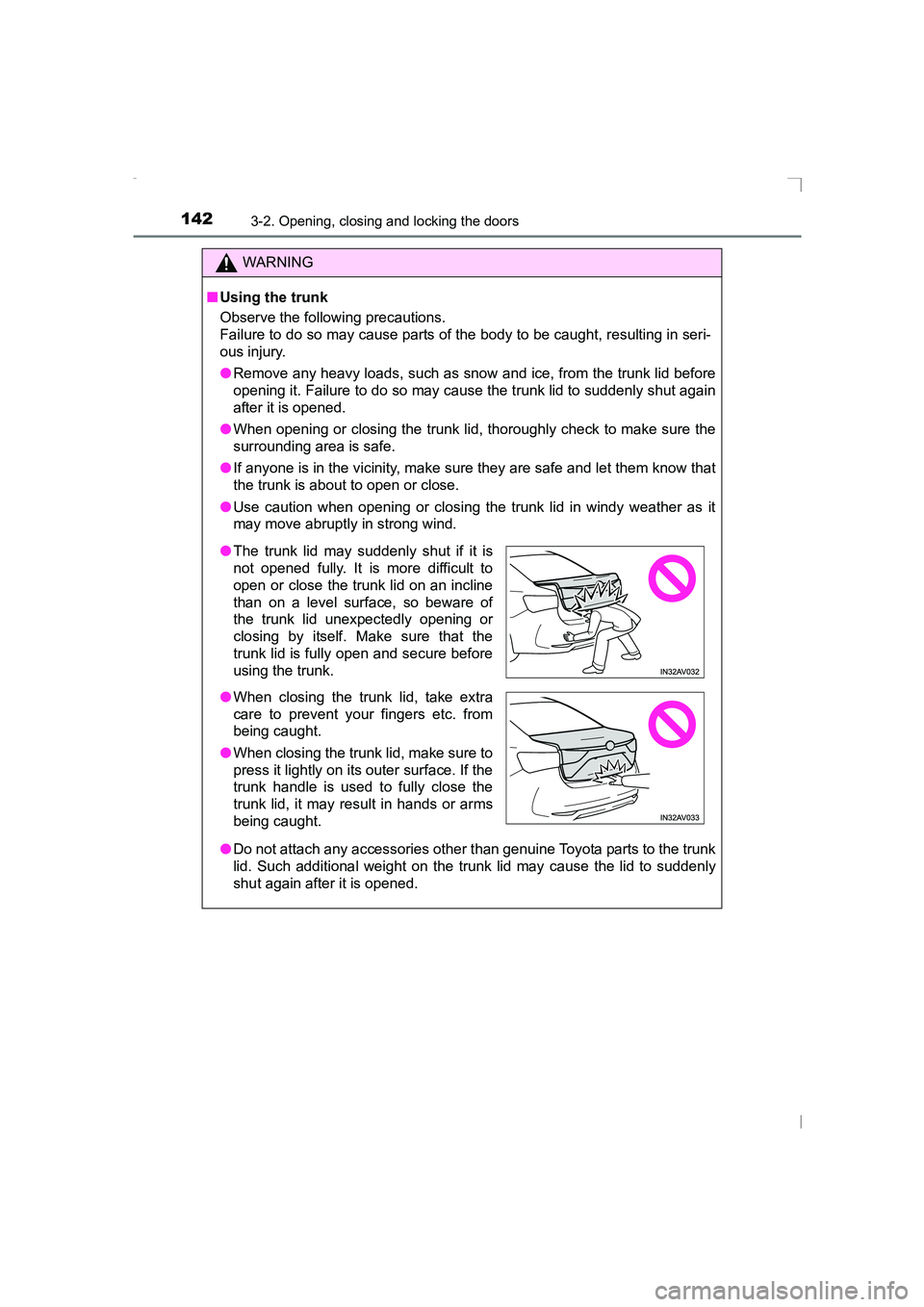
1423-2. Opening, closing and locking the doors
AVENSIS_OM_OM20C20E_(EE)
WARNING
■ Using the trunk
Observe the following precautions.
Failure to do so may cause parts of the body to be caught, resulting in seri-
ous injury.
●Remove any heavy loads, such as snow and ice, from the trunk lid before
opening it. Failure to do so may cause the trunk lid to suddenly shut again
after it is opened.
● When opening or closing the trunk lid, thoroughly check to make sure the
surrounding area is safe.
● If anyone is in the vicinity, make sure they are safe and let them know that
the trunk is about to open or close.
● Use caution when opening or closing the trunk lid in windy weather as it
may move abruptly in strong wind.
● Do not attach any accessories other than genuine Toyota parts to the trunk
lid. Such additional weight on the tr unk lid may cause the lid to suddenly
shut again after it is opened.
● The trunk lid may suddenly shut if it is
not opened fully. It is more difficult to
open or close the trunk lid on an incline
than on a level surface, so beware of
the trunk lid unexpectedly opening or
closing by itself. Make sure that the
trunk lid is fully open and secure before
using the trunk.
● When closing the trunk lid, take extra
care to prevent your fingers etc. from
being caught.
● When closing the trunk lid, make sure to
press it lightly on its outer surface. If the
trunk handle is used to fully close the
trunk lid, it may result in hands or arms
being caught.
AVENSIS_OM_OM20C20E_(EE).book Page 142 Thursday, January 29, 2015 1:47 PM
Page 200 of 648
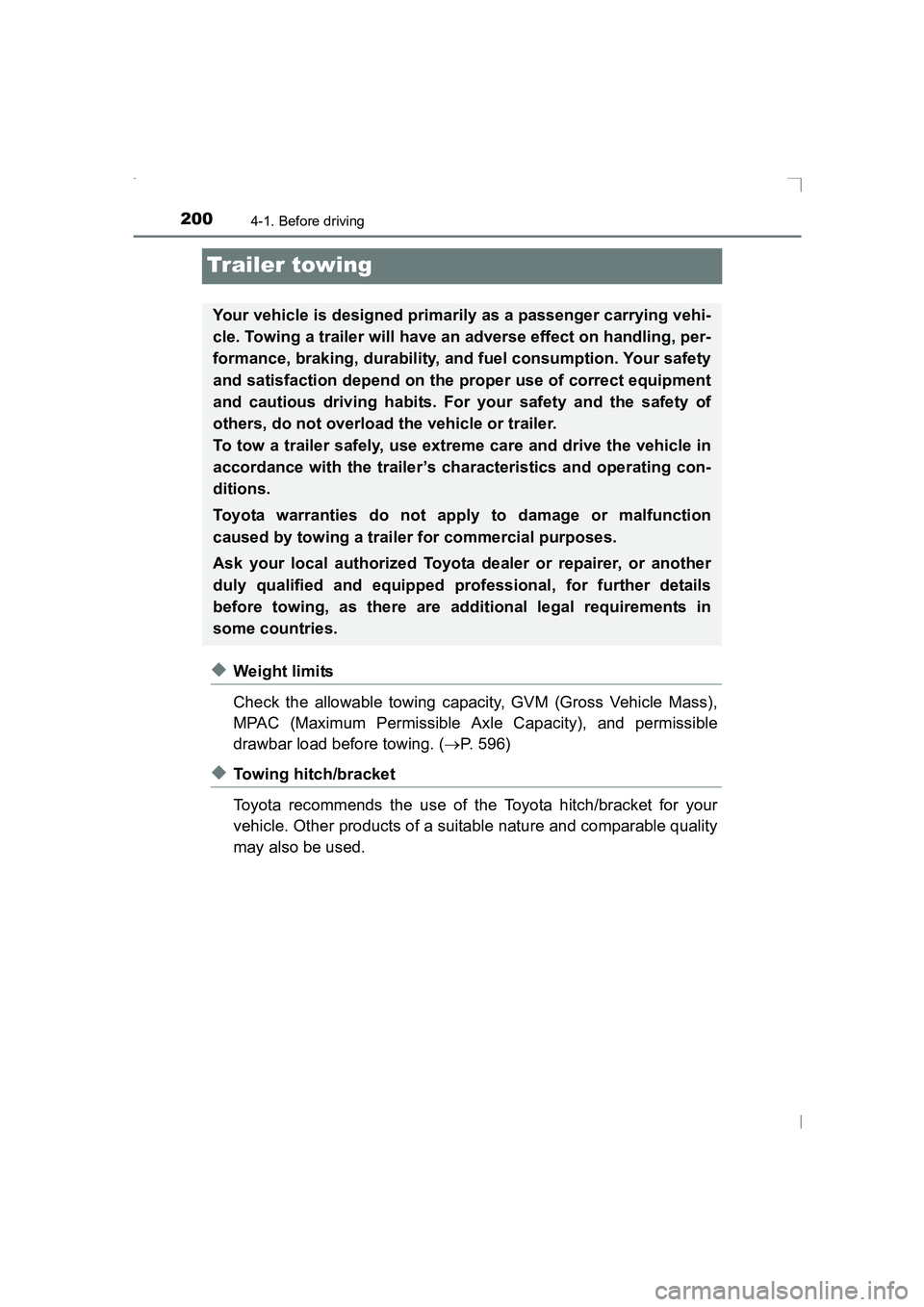
2004-1. Before driving
AVENSIS_OM_OM20C20E_(EE)
Trailer towing
◆Weight limits
Check the allowable towing capacity, GVM (Gross Vehicle Mass),
MPAC (Maximum Permissible Axle Capacity), and permissible
drawbar load before towing. (→P. 596)
◆Towing hitch/bracket
Toyota recommends the use of the Toyota hitch/bracket for your
vehicle. Other products of a suitable nature and comparable quality
may also be used.
Your vehicle is designed primarily as a passenger carrying vehi-
cle. Towing a trailer will have an adverse effect on handling, per-
formance, braking, durability, and fuel consumption. Your safety
and satisfaction depend on the proper use of correct equipment
and cautious driving habits. For your safety and the safety of
others, do not overload the vehicle or trailer.
To tow a trailer safely, use extreme care and drive the vehicle in
accordance with the trailer’s characteristics and operating con-
ditions.
Toyota warranties do not apply to damage or malfunction
caused by towing a trailer for commercial purposes.
Ask your local authorized Toyota dealer or repairer, or another
duly qualified and equipped professional, for further details
before towing, as there are additional legal requirements in
some countries.
AVENSIS_OM_OM20C20E_(EE).book Page 200 Thursday, January 29, 2015 1:47 PM
Page 201 of 648
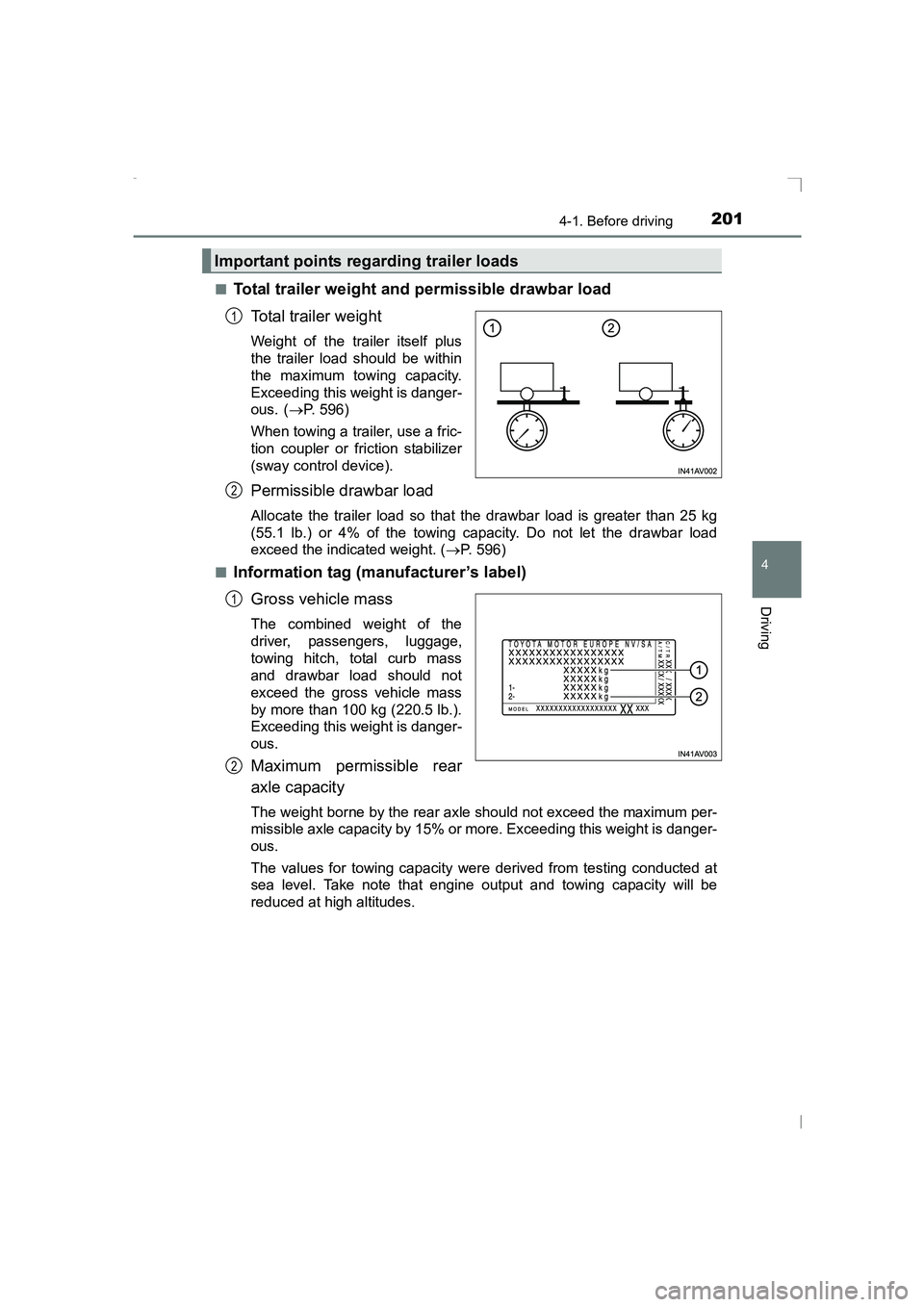
2014-1. Before driving
4
Driving
AVENSIS_OM_OM20C20E_(EE)■
Total trailer weight and permissible drawbar load
Total trailer weight
Weight of the trailer itself plus
the trailer load should be within
the maximum towing capacity.
Exceeding this weight is danger-
ous.
(→ P. 596)
When towing a trailer, use a fric-
tion coupler or friction stabilizer
(sway control device).
Permissible drawbar load
Allocate the trailer load so that the drawbar load is greater than 25 kg
(55.1 lb.) or 4% of the towing ca pacity. Do not let the drawbar load
exceed the indicated weight. ( →P. 596)
■
Information tag (manufacturer’s label)
Gross vehicle mass
The combined weight of the
driver, passengers, luggage,
towing hitch, total curb mass
and drawbar load should not
exceed the gross vehicle mass
by more than 100 kg (220.5 lb.).
Exceeding this weight is danger-
ous.
Maximum permissible rear
axle capacity
The weight borne by the rear axle should not exceed the maximum per-
missible axle capacity by 15% or more. Exceeding this weight is danger-
ous.
The values for towing capacity were derived from testing conducted at
sea level. Take note that engine output and towing capacity will be
reduced at high altitudes.
Important points regarding trailer loads
1
2
1
2
AVENSIS_OM_OM20C20E_(EE).book Page 201 Thursday, January 29, 2015 1:47 PM